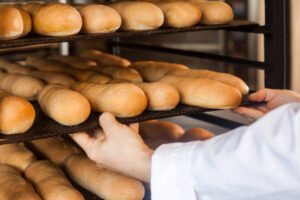 What is Calcium Dihydrogen Diphosphate? What it can do? In this blog, we will explore the four primary roles of Calcium Dihydrogen Diphosphate in bakery products. Understanding the mechanisms behind these functions is key to harnessing the potential of this versatile additive and producing high-quality bakery products.
What is Calcium Dihydrogen Diphosphate? What it can do? In this blog, we will explore the four primary roles of Calcium Dihydrogen Diphosphate in bakery products. Understanding the mechanisms behind these functions is key to harnessing the potential of this versatile additive and producing high-quality bakery products.
Introduction of Calcium Dihydrogen Diphosphate
Calcium Dihydrogen Diphosphate commonly known as Calcium Acid Pyrophosphate abbreviated as CAPP, is a white crystalline powder with the chemical formula CaH2P2O7 and CAS Number 14866-19-4. It is widely used in the food industry as a food additive and plays crucial roles as a leavening agent, dough improver, emulsifier, and acidity regulator in the bakery sector.
Let’s break down its functions and uses.
Roles of Calcium Dihydrogen Diphosphate
Leavening Agent
One of the principal functions of Calcium Dihydrogen Diphosphate is as a leavening agent. When mixed with alkaline substances like sodium bicarbonate (baking soda) in the dough, it releases carbon dioxide gas, which gets trapped, causing the dough to rise and become light and fluffy.
During baking, the heat causes Calcium Dihydrogen Diphosphate to react with baking soda, producing carbon dioxide gas. This gas expands and gets trapped in the dough, making it rise and leading to a light, airy texture in the final product.
In sponge cakes, a mixture of Calcium Dihydrogen Diphosphate and baking soda is added to the batter. The reaction during baking releases carbon dioxide, making the cake rise and giving it a soft, fluffy texture.
Dough Improver
Calcium Dihydrogen Diphosphate also acts as a dough improver by strengthening the gluten network in the dough. This enhancement facilitates better handling and processing of the dough, resulting in the desired texture and volume of the final product.
Calcium Dihydrogen Diphosphate strengthens the gluten network, enhancing its elasticity and extensibility. This improvement results in better dough handling properties and gas retention during fermentation and baking, leading to better volume and texture in the final product.
In bread production, adding Calcium Dihydrogen Diphosphate to the dough improves its handling properties, making it easier to knead and shape. This results in bread with a better volume and texture.
Emulsifier
Calcium Dihydrogen Diphosphate can indirectly aid in the emulsification process. It can help stabilize the dough by binding to water and fats, thereby improving the dough’s consistency and texture.
Calcium Dihydrogen Diphosphate binds to water and fats in the dough, helping to stabilize the mixture. This stabilization improves the dough’s consistency and texture, ensuring even fat distribution throughout the dough and a consistent, tender texture in the final product.
In pastries, Calcium Dihydrogen Diphosphate helps stabilize the dough, ensuring even fat distribution throughout the dough. This results in pastries with a more consistent and tender texture.
Acidity Regulator
Calcium Dihydrogen Diphosphate also serves as an acidity regulator, helping to maintain the dough’s pH level, which is essential for the optimal functioning of other ingredients like yeast and enzymes.
Calcium Dihydrogen Diphosphate can donate or accept hydrogen ions, helping to maintain the dough’s pH level within the desired range. This ensures optimal yeast and enzyme function, leading to better fermentation and a higher-quality final product.
In sourdough bread production, Calcium Dihydrogen Diphosphate helps regulate the dough’s pH, ensuring that the natural yeast and bacteria can ferment the dough properly. This results in bread with the desired sour flavor and texture.
Generally, Calcium Dihydrogen Diphosphate is an essential ingredient in the bakery industry, serving as a leavening agent, dough improver, emulsifier, and acidity regulator.
If you’re looking for Calcium Dihydrogen Diphosphate for your baking business, Please leave a message at [email protected], and we will promptly reach out to you.




